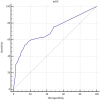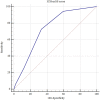Combining modified Graeb score and intracerebral hemorrhage score to predict poor outcome in patients with spontaneous intracerebral hemorrhage undergoing surgical treatment
- PMID: 35968295
- PMCID: PMC9373905
- DOI: 10.3389/fneur.2022.915370
Combining modified Graeb score and intracerebral hemorrhage score to predict poor outcome in patients with spontaneous intracerebral hemorrhage undergoing surgical treatment
Abstract
Objective: Spontaneous intracerebral hemorrhage (sICH) is a frequently encountered neurosurgical disease. The purpose of this study was to evaluate the relationship between modified Graeb Score (mGS) at admission and clinical outcomes of sICH and to investigate whether the combination of ICH score could improve the accuracy of outcome prediction.
Methods: We retrospectively reviewed the medical records of 511 patients who underwent surgery for sICH between January 2017 and June 2021. Patient outcome was evaluated by the Glasgow Outcome Scale (GOS) score at 3 months following sICH, where a GOS score of 1-3 was defined as a poor prognosis. Univariate and multivariate logistic regression analyses were conducted to determine risk factors for unfavorable clinical outcomes. Receiver operating characteristic (ROC) curve analysis was performed to detect the optimal cutoff value of mGS for predicting clinical outcomes. An ICH score combining mGS was created, and the performance of the ICH score combining mGS was assessed for discriminative ability.
Results: Multivariate analysis demonstrated that a higher mGS score was an independent predictor for poor prognosis (odds ratio [OR] 1.207, 95% confidence interval [CI], 1.130-1.290, p < 0.001). In ROC analysis, an optimal cutoff value of mGS to predict the clinical outcome at 3 months after sICH was 11 (p < 0.001). An increasing ICH-mGS score was associated with increased poor functional outcome. Combining ICH score with mGS resulted in an area under the curve (AUC) of 0.790, p < 0.001.
Conclusion: mGS was an independent risk factor for poor outcome and it had an additive predictive value for outcome in patients with sICH. Compared with the ICH score and mGS alone, the ICH score combined with mGS revealed a significantly higher discriminative ability for predicting postoperative outcome.
Keywords: intracerebral hemorrhage score; modified Graeb score; outcome; spontaneous intracerebral hemorrhage; surgical treatment.
Copyright © 2022 Wang, Xu, Yu, Hu, Han and Wang.
Conflict of interest statement
The authors declare that the research was conducted in the absence of any commercial or financial relationships that could be construed as a potential conflict of interest.
Figures





Similar articles
-
A Comparison of the Intracerebral Hemorrhage Score and the Acute Physiology and Chronic Health Evaluation II Score for 30-Day Mortality Prediction in Spontaneous Intracerebral Hemorrhage.J Stroke Cerebrovasc Dis. 2017 Nov;26(11):2563-2569. doi: 10.1016/j.jstrokecerebrovasdis.2017.06.005. Epub 2017 Jul 3. J Stroke Cerebrovasc Dis. 2017. PMID: 28684377
-
The accuracy of ICH-FOS for spontaneous intracerebral hemorrhage: An analysis of ATACH-2 and the Qatar stroke database.J Clin Neurosci. 2025 Jun;136:111214. doi: 10.1016/j.jocn.2025.111214. Epub 2025 Apr 3. J Clin Neurosci. 2025. PMID: 40184821
-
Evaluation of intraventricular hemorrhage assessment methods for predicting outcome following intracerebral hemorrhage.J Neurosurg. 2012 Jan;116(1):185-92. doi: 10.3171/2011.9.JNS10850. Epub 2011 Oct 14. J Neurosurg. 2012. PMID: 21999319
-
Predictive Nomogram for Unfavorable Outcome of Spontaneous Intracerebral Hemorrhage.World Neurosurg. 2022 Aug;164:e1111-e1122. doi: 10.1016/j.wneu.2022.05.111. Epub 2022 May 30. World Neurosurg. 2022. PMID: 35654327 Review.
-
Potential blood biomarkers that can be used as prognosticators of spontaneous intracerebral hemorrhage: A systematic review and meta-analysis.PLoS One. 2025 Feb 19;20(2):e0315333. doi: 10.1371/journal.pone.0315333. eCollection 2025. PLoS One. 2025. PMID: 39970158 Free PMC article.
Cited by
-
Dramatic Reanimation and Spontaneous Re-Canalization of a Fourth Ventricular Hemorrhage: "REVIVE" Phenomenon.Neurohospitalist. 2024 Oct 4:19418744241289972. doi: 10.1177/19418744241289972. Online ahead of print. Neurohospitalist. 2024. PMID: 39544273 Free PMC article.
-
Predictive value of hyponatremia for short-term mortality in supratentorial spontaneous intracerebral hemorrhage: a single center study.Front Neurol. 2024 Jan 25;15:1301197. doi: 10.3389/fneur.2024.1301197. eCollection 2024. Front Neurol. 2024. PMID: 38333609 Free PMC article.
-
Short-term mortality prognosis in spontaneous intracranial hemorrhage: A retrospective study at 115 People's Hospital, HCMC, Vietnam.J Public Health Res. 2025 Apr 18;14(2):22799036251334178. doi: 10.1177/22799036251334178. eCollection 2025 Apr. J Public Health Res. 2025. PMID: 40296883 Free PMC article.
-
A novel nomogram for predicting prolonged disorders of consciousness in severe supratentorial hypertensive intracerebral hemorrhage patients.Sci Rep. 2025 Jul 17;15(1):25911. doi: 10.1038/s41598-025-11798-x. Sci Rep. 2025. PMID: 40676114 Free PMC article.
-
Usefulness of Serum NOX4 as a Potential Biomarker to Predict Early Neurological Deterioration and Poor Outcome of Spontaneous Intracerebral Hemorrhage: A Prospective Observational Study.Neuropsychiatr Dis Treat. 2025 Feb 19;21:295-307. doi: 10.2147/NDT.S512801. eCollection 2025. Neuropsychiatr Dis Treat. 2025. PMID: 39989662 Free PMC article.
References
LinkOut - more resources
Full Text Sources

